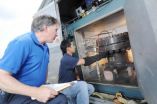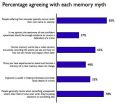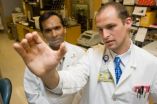(Press-News.org) In August of 2016, when NASA's Juno Mission begins sending back information about the atmosphere of the planet Jupiter, research done by Georgia Institute of Technology engineers using a 2,400-pound pressure vessel will help scientists understand what the data means. The Juno probe is scheduled to be launched August 5 from Cape Canaveral Air Force Station in Florida.
Because Jupiter has been largely unchanged since its formation at the birth of our solar system, scientists hope Juno will resolve unanswered questions not only about the massive planet, but also about how our solar system evolved. Among the key questions are how much water exists there, and how that water evolved from the hydrogen-rich early solar system.
"Jupiter collected much of the original solar nebula, that sheet of material that surrounded our sun when it formed," said Paul Steffes, a professor in Georgia Tech's School of Electrical and Computer Engineering and a member of the Juno Mission Team. "Knowing how much water is in the atmosphere of Jupiter is going to give us real insight into how the whole solar system has evolved. Understanding Jupiter really helps us understand how we got started."
To detect and measure water, Juno will carry a radiometer that can measure radio emissions produced by the planet itself at microwave frequencies. As those signals pass through Jupiter's atmosphere, they are altered by the water and other constituents. Understanding how the signals were altered can tell scientists much about the atmosphere of the giant planet. The probe will receive microwave signals at six different frequencies that scientists know are emitted at various levels of the planet's atmosphere.
"The intensity of the microwave radiation at specific frequencies gets weaker depending on how much water is there," Steffes explained. "We'll be able to not only say whether or not there's water there, but we'll also be able to say at what altitude it exists based on the signatures of the microwaves coming out of the planet's atmosphere."
Interpreting that data will require knowledge that Steffes and his students are developing by simulating the Jupiter atmosphere in their pressure vessel, which is located inside an oven on the roof of Georgia Tech's Van Leer Building.
Though Jupiter is a long way from the sun, the planet's gravitational forces create high temperatures and tremendous pressures in the lower layers of the atmosphere where the water is believed to exist. The laboratory atmospheric simulations allow Steffes and his students to study the behavior of microwave signals passing through ammonia, hydrogen sulfide, helium, hydrogen and water vapor at pressures up to 100 times those of the Earth.
The researchers, including graduate student Danny Duong, have made thousands of measurements at different temperatures, pressures and microwave frequencies as the signals pass through different combinations of gases. The laboratory work is expected to be completed during 2012.
"The measurements we've made will allow the radiometer on Juno to be calibrated," Steffes explained. "When Juno gets to Jupiter, we'll know what conditions each microwave signature corresponds to."
Earlier attempts to quantify the water on Jupiter – the solar system's largest planet – produced conflicting information. Steffes assisted the Galileo mission, which dropped a probe into the planet's atmosphere in 1995 and found surprisingly little water. Yet when the Comet Shoemaker-Levy crashed into Jupiter in 1994, it stirred up oxygen that led scientists to believe water was abundant.
Once Juno reaches the planet, it will go into an elliptical polar orbit to avoid Jupiter's deadly radiation belts, which would harm the probe's electronic systems. Juno is scheduled to make 30 orbits, each of which will take 11 days. The researchers then expect to take about 18 months to process the information sent back to Earth.
Beyond measuring water on Jupiter, Juno will also study the planet's gravitation field in an effort to determine whether a solid core exists and how the giant body rotates. It will also measure magnetic fields and investigate Jupiter's auroras, which are the strongest in the solar system. And it will take a look at the planet's polar areas for the first time ever.
Juno is also notable because it will be the first deep-space probe to be powered by photovoltaic arrays, which were less expensive than the nuclear generators used on earlier missions.
Steffes has been studying planetary atmospheres for more than 25 years, and has simulated conditions on Venus, Neptune, Saturn and Uranus in addition to Jupiter. The work has continued under the same contract since 1984.
Georgia Tech's research into other planets goes back more than 50 years, Steffes noted.
Studies of other planetary atmospheres can now be done from Earth using radio telescopes such as the Very Large Array in New Mexico, or the new Atacama array in Chile. But Jupiter's radiation belts, which are made up of energized particles spewed into the atmosphere by the volcanic moon Io, prevent that.
"To test for water, you have to operate at frequencies that are pretty low, about the same as a cell phone," Steffes said. "But the radiation belts are generating huge amounts of noise at those frequencies, so we couldn't do this observation from Earth because the radiation belts would mask the signal from Jupiter's atmosphere. We are very fortunate to have this opportunity to observe Jupiter with the Juno spacecraft."
INFORMATION:
NASA's Jet Propulsion Laboratory in Pasadena, Calif., manages the Juno mission for the principal investigator, Scott Bolton of Southwest Research Institute in San Antonio, Texas.
Atmospheric simulations will help NASA interpret data from the Juno Mission to Jupiter
2011-08-04
ELSE PRESS RELEASES FROM THIS DATE:
Scientists identify what makes us feel 'bad' when we're sick, how to treat it
2011-08-04
PORTLAND, Ore. — A signaling system in the brain previously shown to regulate sleep is also responsible for inducing lethargy during illness, according to research conducted at Oregon Health & Science University Doernbecher Children's Hospital.
This research is particularly meaningful because it implies that a new class of drugs developed to treat sleep disorders can reverse the inactivity and exhaustion brought on by acute illness. Although the sleep drugs were initially designed to treat narcolepsy, they have the potential to restore energy and motivation in patients ...
IT solution to improve hospital workflow and schedules
2011-08-04
A new customised IT business management system developed by Queensland University of Technology (QUT) researchers and capable of improving the scheduling of resources and workflow in surgical theatres has been successfully demonstrated in a German hospital.
Dr Chun Ouyang, from QUT's Business Process Management (BPM) group, said the system was built based on an automated workflow system known as YAWL, and allowed hospitals to more efficiently manage the co-ordination of expensive surgery-related resources.
The project is being undertaken in partnership with German ...
Science showcase presents psychology's 'hands-on' benefits
2011-08-04
WASHINGTON – The American Psychological Association plans to feature three public demonstrations of psychological science applications, including one that enables "seeing" with one's ears rather than eyes, at the organization's 119th Annual Convention here this week.
The Science Showcase will be open to the public Aug. 5 and 6, near the entrance to the convention exhibits and registration area at the Walter E. Washington Convention Center.
"The science of psychology affects everyone's daily life in ways that most people don't realize," said Steven J. Breckler, ...
National survey reveals widespread mistaken beliefs about memory
2011-08-04
CHAMPAIGN, Ill. — A new survey reveals that many people in the U.S. – in some cases a substantial majority – think that memory is more powerful, objective and reliable than it actually is. Their ideas are at odds with decades of scientific research.
The results of the survey and a comparison to expert opinion appear in a paper in the journal PLoS ONE.
(Before reading further, test your own ideas about memory.)
"This is the first large-scale, nationally representative survey of the U.S. population to measure intuitive beliefs about how memory works," said University ...
Lifestyles of the old and healthy defy expectations
2011-08-04
VIDEO:
People who live to 95 or older are no more virtuous than the rest of us in terms of their diet, exercise routine or smoking and drinking habits, according to...
Click here for more information.
August 3, 2011 — (Bronx, NY) — People who live to 95 or older are no more virtuous than the rest of us in terms of their diet, exercise routine or smoking and drinking habits, according to researchers at Albert Einstein College of Medicine of Yeshiva University.
Their findings, ...
Mayo Clinic finds new bacterium causing tick-borne illness ehrlichiosis in Wis., Minn.
2011-08-04
ROCHESTER, Minn. -- A new tick-borne bacterium infecting humans with ehrlichiosis has been discovered in Wisconsin and Minnesota. It was identified as a new strain of bacteria through DNA testing conducted at Mayo Clinic. The findings appear in the Aug. 4 edition of the New England Journal of Medicine.
Doctors at Mayo Clinic, the Centers for Disease Control and Prevention (CDC), the University of Minnesota, the University of Wisconsin, and state and local health departments say the new species from the Ehrlichia genus can cause a feverish illness in humans. The new bacterium, ...
Standard aplastic anemia therapy improves patient outcomes better than newer version
2011-08-04
A comparison clinical study of two aplastic anemia treatments found that ATGAM, currently the only licensed aplastic anemia drug in the United States, improved blood cell counts and survival significantly more than did Thymoglobulin, a similar but reportedly more potent treatment. The research was funded by the National Heart, Lung, and Blood Institute (NHLBI), a part of the National Institutes of Health; the study participants were treated and then followed at the NIH Clinical Center in Bethesda, Maryland.
The study will appear in the August 4 New England Journal of ...
B.C. researchers find quick, low-cost tests can accurately identify childhood developmental delays
2011-08-04
BC Children's Hospital and University of British Columbia (UBC) researchers have found that two existing screening tests are accurate in diagnosing development delays in children and could be incorporated in a busy family practice setting with relative ease.
Parents can complete the Ages and Stages Questionnaire (ASQ) or the Parents' Evaluation of Developmental Status (PEDS) at home or in the family physician's office, with the physician scoring the tests and providing results in a matter of minutes.
"Only 30 per cent of children with developmental delays are identified ...
Urine test shows prostate cancer risk, U-M study finds
2011-08-04
ANN ARBOR, Mich. — A new urine test can help aid early detection of and treatment decisions about prostate cancer, a study from the University of Michigan Comprehensive Cancer Center and the Michigan Center for Translational Pathology finds.
The test supplements an elevated prostate specific antigen, or PSA, screening result, and could help some men delay or avoid a needle biopsy while pointing out men at highest risk for clinically significant prostate cancer.
The test looks for a genetic anomaly that occurs in about half of all prostate cancers, an instance of two ...
6 million years of savanna
2011-08-04
SALT LAKE CITY, Aug. 3, 2011 – University of Utah scientists used chemical isotopes in ancient soil to measure prehistoric tree cover – in effect, shade – and found that grassy, tree-dotted savannas prevailed at most East African sites where human ancestors and their ape relatives evolved during the past 6 million years.
"We've been able to quantify how much shade was available in the geological past," says geochemist Thure Cerling, senior author of a study of the new method in the Thursday, Aug. 4, 2011 issue of the journal Nature. "And it shows there have been open ...



